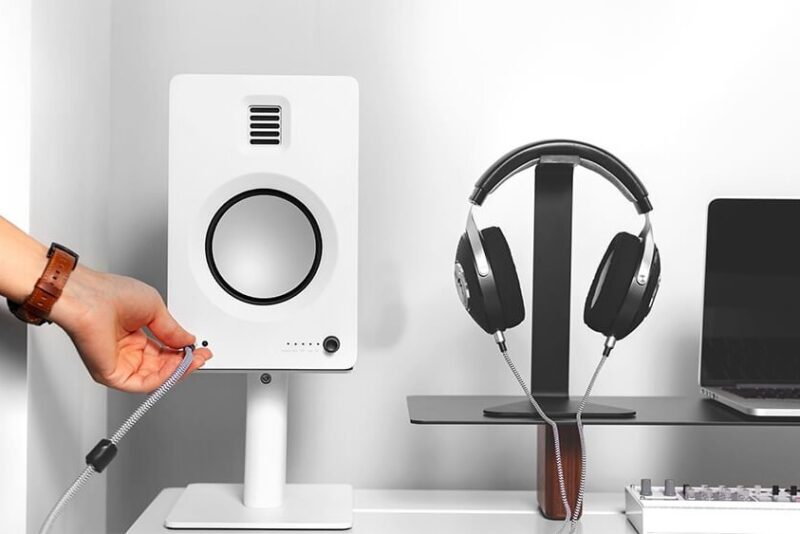Searching for the best powered speakers to put on your computer desk? Check out our Kanto TUK Review! We cover sound, design, and performance!
(Editor’s Note: The list price of the Kanto TUK has increased to $899 since we originally reviewed it.)
At one point, I considered Kanto to be the company that made cool little speakers for your desktop. That was until I went to the last Rocky Mountain Audio Fest back in 2019. That’s where Kanto officially unveiled their then-new Flagship speaker called TUK. It was different than the simple, compact models that were and still are their bread and butter.
At a list price of $799, TUK is their first speaker with a price above $500. It’s also their first to use an AMT (Air Motion Transformer) tweeter (the rest use dome tweeters) for enhanced high-end clarity and soundstage. That AMT tweeter is mated to a 5” aluminum driver, another first for Kanto, no doubt to provide extended bass while limiting distortion.
This speaker is the Canadian company’s first stab at “high-end audio,” and the specs are impressive.
I received advance notice (via a press release) that TUK would be at RMAF, so I looked forward to hearing them. I was able to have an extended listen in the Kanto demo room, and I was impressed by what I heard.

Fast forward several months later, and there I was with a White pair on my desktop (they also come in Black), ready to give them a thorough listen in my natural habitat. After many months of listening to them just about every day, I’m ready to give my impressions. Disclaimer: The TUK was sent to me in exchange for an honest review, and that is what follows.
Kanto TUK Review: Build/Features
The TUK speaker system is a powered speaker pair, meaning one of the speakers contains the amplifier, while the other is passive. That contrasts with an active speaker pair where each box has its own amplifier (or several amplifiers) built-in.
In Kanto’s TUK case, the active speaker has a 2 channel, 65W per channel Class D amp. That speaker connects to the passive speaker via an included speaker wire pre-terminated with gold-plated banana plugs. I’m happy they don’t lock you into a wire with proprietary plugs on the end like some other manufacturers, which makes it a lot easier to swap cables if need be.
You can even upgrade your speaker wire if you’re into that sort of thing.
TUK is equipped with loads of connectivity options, including a dedicated phono input, RCA line-in, Digital Optical in, USB DAC input, and Bluetooth 4.2 with aptX HD and AAC codecs.
It also has a subwoofer output connected to an active crossover, which steers frequencies under 80hz to a powered subwoofer when plugged in.
There’s a 3.5mm headphone jack on the front so you can do some private listening if you wish. I found it quite powerful and clean, driving my Focal Elear headphones to ear-splitting levels with no problem.
Like most integrated Headphone amp circuits, it can’t compare to better standalone amps, but it could replace some budget models. I like to use it for casual listening when I’m playing music from my laptop via USB.

As you can see, the TUK system is very versatile, allowing them to play nicely with many different components, like Turntables, TVs, and CD players.
It doesn’t have advanced wireless capabilities, like Chromecast, Apple Airplay, or multi-room setups like Play-Fi. On the wired side, there’s also no HDMI (eARC).
This isn’t the end of the world, but it’s something to note. I didn’t miss any of that stuff in the nearfield domain of my desktop workspace.
As far as Build Quality goes, when you talk about High-End speakers, TUK definitely looks and feels the part. The cabinets are heavy and solid, and a quick rap on the side with your knuckles shows how inert they are. The input selector/power knob operates smoothly, and the headphone jack is well integrated into the speaker’s front baffle. Overall, it’s a clean, minimalist design that looks really good.
The remote was solid, just like the speakers, and I loved how the buttons were laid out. The operation was quite intuitive. It had both tone and playback controls and the basics like power, input, and volume.
It also had some neat tricks, like a button to turn the subwoofer signal on/off, and a nifty button that dims the front LED light. It’s a cool feature for people (like me) who can’t stand a bright blue light staring them in the face when it’s dark.

Kanto TUK Review: Sound Test
I set up the TUKs on my desktop with a pair of IsoAcoustics Aperta stands for my sound tests. That allowed me to isolate them from the desktop surface and ensure I heard the speakers and not the desk. The speakers’ rear was about two inches from the wall, way closer than the 8” suggested in the manual, but it didn’t seem to cause any issues with sound.
I played music from several different sources, starting with a quick Bluetooth connection using the aptX HD codec. AptX HD provides sound slightly better than CD-Quality, and I enjoyed TIDAL’s sound over the Bluetooth connection immensely. The soundstage wasn’t all that wide, but imaging was good. Tonal balance was nice, if not a little lean on the low end, but there wasn’t any part of the spectrum that I found offensive.
Listening to “Working Class Hero” off of the new John Lennon project, “Gimme Some Truth”, John and his guitar were centered perfectly between the speakers. The focus could’ve been a little bit sharper, but his vocals were delivered with both delicacy and warmth. The guitar plucks also had a nice body to them. Even though the speakers were directly in front of me, the perspective was set back slightly, which I liked. I hate when speakers shout at you, and the TUKs didn’t do that.
Next, I tried using the included 3.5mm to stereo RCA cable, plugged into the headphone jack of my phone, and the sound was similar but with more focus and detail. I still wished the performance was a little more fleshed out, with more dimensionality, but at the same time, it was still quite musical, making me feel like I had a seat at City Winery, someplace in the middle of the room.
Last, I tried out the USB input, plugging in the other cable included in the package, a USB A to B cable. I played the John Lennon tune again and got the best results out of the three connections. With the USB, I got the best focus and detail, along with a little widening of the soundstage.
At this point, I also wanted to try something a little more upbeat, so I tried an Electronic/House song called “Simulation” by Róisín Murphy. Again, this song let me know these speakers were not going to shake the house without some subwoofer, but they did enough on the low end to give these speakers some drive. They can still make you nod your head.

Kanto TUK Review: The Wrap Up
The first time I listened to the TUKs, I listened to them for about 3 hours straight. I couldn’t pull myself away from them. I loved the way the music just drew me in. The imaging was nicely focused, the detail was good, and had just enough bass to give music the proper weight. They are very refined for the price, with excellent tonal balance.
Some may think they don’t have enough bass, but I like a balanced speaker. They also don’t have many fancy wireless options like many new active speakers, but there are many connections, so you can pretty much plug in any source, including a turntable. If you’re looking for a set of audiophile-quality powered speakers that are simple to operate and will bring your music to life, these are worth checking out.
Where to Buy:
Kanto TUK Powered Speakers
Crutchfield
$799
[maxbutton id=”1″ url=”https://bit.ly/3q7o3xB” ]

I’m an audio writer who started as a young audio salesman/consumer electronics professional back in the late 90s. That’s where I discovered the magic of 2-Channel sound. My hunger for great sound has led me on a delightful music quest that continues today.



Leave a Reply